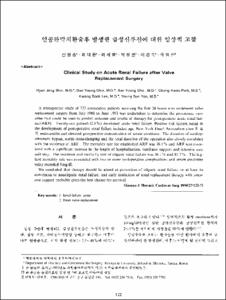KUMEL Repository
1. Journal Papers (연구논문)
1. School of Medicine (의과대학)
Dept. of Thoracic & Cardiovascular Surgery (흉부외과학)
인공판막치환술후 발생한 급성신부전에 대한 임상적 고찰
- Keimyung Author(s)
- Choi, Sae Young; Park, Chang Kwon; Lee, Kwang Sook; Yoo, Young Sun
- Journal Title
- 대한흉부외과학회지
- Issued Date
- 1994
- Volume
- 27
- Issue
- 2
- Abstract
- A retrospective study of 737 consecutive patients surviving the first 24 hours who underwent valve replacement surgery from July 1980 to June 1993 was undertaken to determine the prevalence, variables that could be used to predict outcome and results of therapy for postoperative acute renal failure[ARF]. Twenty-one patients[2.8 %] developed acute renal failure. Positive risk factors noted in the development of postoperative renal failure included age, New York Heart Association class III & IV, endocarditis and elevated preoperative concentration of serum creatinine. The duration of cardiopulmonary bypass, aortic cross-clamping and the total duration of the operation also closely correlated with the incidence of ARF. The mortality rate for established ARF was 38.1% and ARF was associated with a significant increase in the length of hospitalization, ventilator support and intensive care unit stay. The incidence and mortality rate of oliguric renal failure was 38.1% and 85.7%. The highest mortality rate was associated with two or more postoperative complications and serum creatinine value exceeded 5 mg/dl. We concluded that therapy should be aimed at prevention of oliguric renal failure, or at least its conversion to nonoliguric renal failure, and early institution of renal replacement therapy with intensive support probably gives the best chance for survival.
- Alternative Title
- Clinical Study on Acute Renal Failure after Valve Replacement Surgery
- Publisher
- School of Medicine
- Citation
- 신현종 et al. (1994). 인공판막치환술후 발생한 급성신부전에 대한 임상적 고찰. 대한흉부외과학회지, 27(2), 122–127.
- Type
- Article
- ISSN
- 0301-2859
- Appears in Collections:
- 1. School of Medicine (의과대학) > Dept. of Thoracic & Cardiovascular Surgery (흉부외과학)
- 파일 목록
-
-
Download
 oak-bbb-5463.pdf
기타 데이터 / 398.66 kB / Adobe PDF
oak-bbb-5463.pdf
기타 데이터 / 398.66 kB / Adobe PDF
-
Items in Repository are protected by copyright, with all rights reserved, unless otherwise indicated.